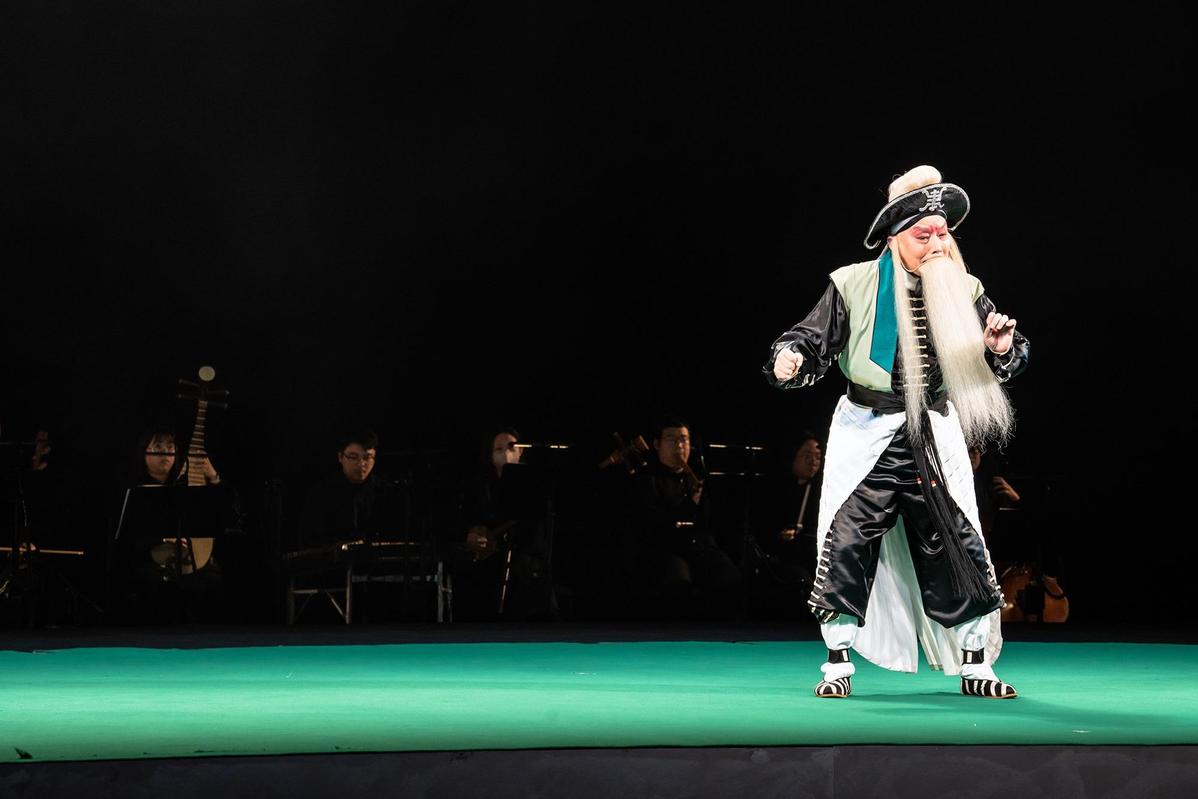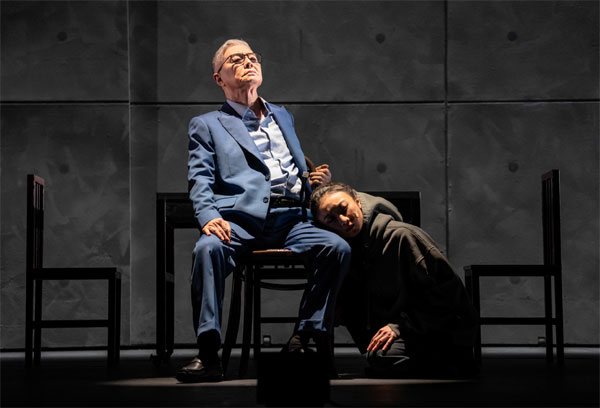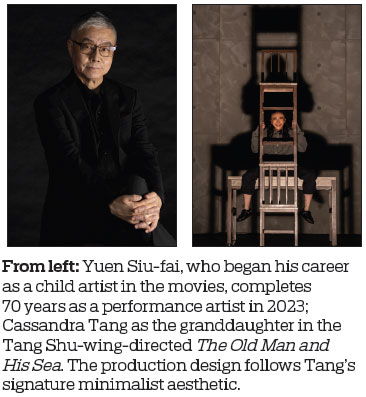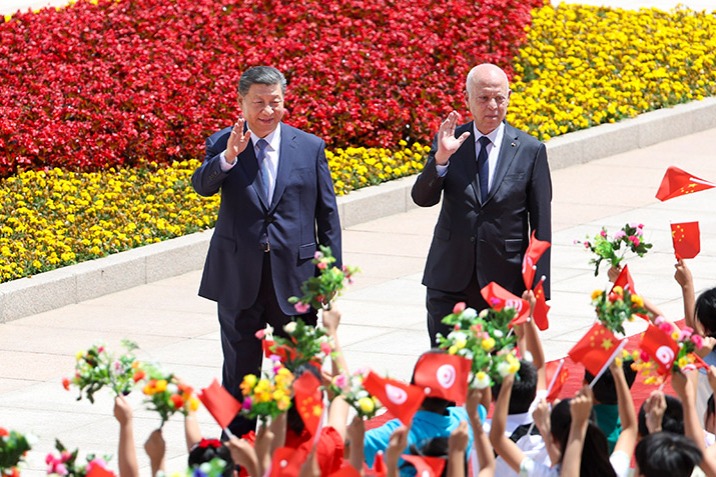Age cannot wither

Cantonese Opera legend Yuen Siu-fai teamed up with leading thespian Tang Shu-wing to present a stage adaptation of Ernest Hemingway's novella The Old Man and the Sea. Chitralekha Basu reports on this epic collaboration.

Anumber of productions in the 2023 New Vision Arts Festival (NVAF) - Hong Kong's annual showcase of new experimental works for the stage selected from around the world - were about revisiting the classics. The list includes Book of Mountains and Seas, a retelling of ancient Chinese creation myths, brought to life through gigantic puppets made from trash by puppeteer and director Basil Twist, and soulful a cappella singing by the vocalists of Ars Nova Copenhagen. The Improbable theater production Tao of Glass, in which director Phelim McDermott examines his sustained and obsessive interest in the virtuoso composer and pianist Philip Glass - using the latter's compositions as a springboard to launch into meditations on the transience of life, while taking his cues from the tenets of Taoist philosophy - is another fine example.
However, for Hong Kong people, perhaps none of NVAF's homage to the icons hits as close to home as The Old Man and His Sea. The production is local Cantonese Opera legend Yuen Siu-fai's tribute to Ernest Hemingway's 1952 novella The Old Man and the Sea as well as a celebration of Yuen's 70 years as a performance art professional.
Starting off as a child artist in the 1953 film Honor Thy Father and Mother, Yuen went on to have an illustrious career as a Cantonese Opera performer and trainer. He is also a highly respected academic and an author of scholarly books that critically examine the Cantonese Opera form and the artist's vocation.
For The Old Man and His Sea, Yuen adapted Hemingway's celebrated work into a Cantonese-Opera dramatic monologue, which he also performs. It is a set piece, which appears as a key element within the framework of a contemporary theater design, directed by one of Hong Kong's leading exponents of experimental stage productions, Tang Shu-wing.

Last icon of Cantonese Opera
Yuen was drawn to Hemingway's book after watching the 1958 film version directed by John Sturges, with Spencer Tracy in the lead. The novella tells the story of Santiago, a fisherman who goes out alone into the sea to hunt down a giant marlin. This solitary journey lands him in a brutal environment that includes bloodthirsty sharks, relentlessly attacking his catch. The book is Hemingway's paean to the almost-magical human ability to triumph against seemingly insurmountable odds, including the decrepitude brought on by old age.
As someone who has actively campaigned for elderly actors' right to work, Yuen understands the challenges faced by an aging performing artist only too well. Tang, his collaborator on The Old Man and His Sea, agrees that the production can be read as a "semi-autobiographical" work. For his solo act, Yuen plays Santiago as an archetypal Cantonese Opera old man with a generic flowing white beard. The piece lasts 35 minutes, and involves nonstop movements and voice acting performed on a bare stage without props. This remarkable feat by a 78-year-old adds an extra layer of meaning to the theme of not letting age get in the way of achieving one's goal.
The Old Man and His Sea is an opportunity to watch one of the last superstars of Cantonese Opera in action, and at the same time reflect on the future of a performance form that seems to be having trouble with attracting audiences under 50. "He is one of the last icons of Cantonese Opera performers from Hong Kong who possesses a solid set of skills and is also very respectful toward preserving the authenticity of the performance form," Tang says. "And he is obviously worried about Cantonese Opera going down the road of extinction."

Illuminating the present
Yuen's keenness to preserve and promote the authentic Cantonese Opera form is not at odds with his wish to see it through the lens of contemporary theater. Though, on the face of it, the two art forms are products of two distinct sensibilities, separated by around 600 years, Tang points out that the minimalist aesthetic of his own theater practice resonates with that of traditional Chinese opera, which, typically, plays in an empty environment with minimal scenic elements.
Both Yuen and Tang were taken by Hemingway's story for its epic vision about the human capacity for survival and renewal. They had set about their collaborative project with the hope that it would "hopefully reveal something about our own time to a contemporary audience", Tang says.
He invented a story to frame Yuen's Cantonese Opera solo act based on Hemingway's novella. In it, a young woman (played by Cassandra Tang) receives a diary left to her by her deceased grandfather (Yuen again). They had never met before, but she feels an instant connection with him through his words, for they embody an artist's legacy. The woman finds out that the grandfather was inspired by Hemingway's The Old Man and the Sea and wanted to adapt it into Cantonese Opera but never got around to doing it. What had remained unachieved in real life becomes achievable when the granddaughter crosses over to a realm of fantasy where she can watch the grandfather perform his prized role.
The idea was to highlight the perennial stream of creativity and creative legacy that can transcend the barriers of culture, time and space. "The grandfather-granddaughter relationship in our production is analogous to that of the old man and the boy who sometimes works on his boat in Hemingway's novel. They affect each other's life's journeys," Tang observes. "I was looking for a plot to represent the perennial elements of life."
He also wanted to make a point about how porous the line separating male and female identities can sometimes get. In his story, the estrangement between the grandfather and granddaughter results after the girl's father comes out as gay and has to leave his father's home as a consequence. Many people in Hong Kong still aren't too comfortable around nonbinaries, Tang points out. By contrast, "traditionally, men have played female roles and vice versa in Chinese opera," he says. "The mixing-up of genders in Chinese opera, which has been in practice for many years, adds a different layer of color and texture to the form."

World in a grain of sand
At one point in the show, the granddaughter sits down to watch a slide show, projected on a giant regal Cantonese Opera costume-shaped screen. The images are mainly of armed soldiers in conflict zones. There are also glimpses of dying birds, coated in dark oil - victims of oil spills in the sea.
Tang says he chose images that are likely to trigger an instant recall. "They have to do with the planet we live in and the fact that we are in danger," he says. "But there are a few other kinds of images as well, showing young people - a smiling, young girl, for instance," he hastens to add. "So the pictures seem to suggest the options in front of us. The choices one makes are of course up to the individual, but it is important to make those choices."
Using a Cantonese Opera costume-shaped cutout as the projection screen, he says, is meant to be a reminder that the original purpose of Chinese opera was to educate the audience and disseminate information. "The idea here is that the characters are in fact watching something much larger than themselves and the story playing out on the stage," he says.
It's an attempt to present the world in a microcosm, as Hemingway's novella does.
Contact the writer at basu@chinadailyhk.com
- Former Shandon political advisor imprisoned for accepting bribes
- Australia launches studies program for China-Australia exchange
- Harbin Institute of Technology celebrates group student wedding with special diamonds
- Beijing hospital promotes clinical trial awareness and participation
- Community cinema: open-air magic in Yinchuan nights
- Drone captures rare moment: Porpoises frolic at sea


































